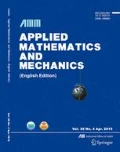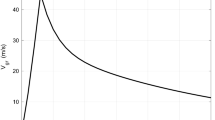Abstract
The polar low and tropical cyclone type vortices over topography are assumed to be the axisymmetrical and thermal-wind balanced systems, which are solved as an initial value problem of a linearized vortex equation set in cylindrical coordinates. The roles of the sensible and latent heating, friction, and topography in the structure and intensification of the polar low and tropical cyclone type vortices are analyzed. The radial velocity, vertical velocity, azimuthal velocity, and the unstable growth rate including the topography effects are obtained. It is shown that the interaction between the flow and the topography plays a significant role in the structure and intensification of the polar low and tropical cyclone system. The analysis of the topography term indicates that, in the up-slope side of the mountain, the radial inflow and the vertical ascent forced by the mountain can intensify the polar low and tropical cyclone type vortex and increase the unstable growth rate. However, in the lee side of the mountain, the radial inflow and the vertical descent forced by the mountain can weaken the polar low and tropical cyclone type vortex and decrease the unstable growth rate of the polar low and tropical cyclone system. In addition, the evolutionary process and the spatial structure of the polar low observed over the Japan Sea on 19 December 2003 are investigated with the observational data to verify this theoretical result.
Similar content being viewed by others
References
Harley, D. G. Frontal contour analysis of a “polar low”. Meteorol. Mag. 89, 146–147 (1960)
Fu, G., Niino, H., Kimura, R., and Kato, T. A polar low over the Japan Sea on 21 January 1997, part I: observational analysis. Monthly Weather Review 132, 1537–1551 (2004)
Rasmussen, E. A. and Turner, J. Polar Lows, Mesoscale Weather Systems in the Polar Region, Cambridge University Press, Cambridge (2003)
Mansfield, D. A. Polar lows: the development of baroclinic disturbances in cold air outbreaks. Q. J. R. Meteorol. Soc. 100(426), 541–554 (1974)
Rasmussen, E. The polar low as an extratropical CISK-disturbance. Q. J. R. Meteorol. Soc. 105(445), 531–549 (1979)
Shapiro, M. A., Fedor, L. S., and Hampel, T. Research aircraft measurements of a polar low over the Norwegian Sea. Tellus A 39A, 272–306 (1987)
Ninomiya, K. Polar/comma-cloud lows over the Japan Sea and the northwestern Pacific in winter. Journal of the Meteorological Society of Japan 67(1), 83–97 (1989)
Tsuboki, K. and Wakahama, G. Mesoscale cyclogenesis in winter monsoon air streams: quasigeostrophic baroclinic instability as a mechanism of the cyclogenesis off the west coast of Hokkaido Island, Japan. Journal of the Meteorological Society of Japan 70(1), 77–93 (1992)
Lee, T. Y., Park, Y. Y., and Lin, Y. L. A numerical modeling study of mesoscale cyclogenesis to the east of Korean Peninsula. Monthly Weather Review 126(9), 2305–2329 (1998)
Fu, G. Polar Lows: Intense Cyclones in Winter, China Meteorology Press, Beijing, 218 (2001)
Yanase, W., Niino, H., and Saito, K. High-resolution numerical simulation of a polar low. Geophys. Res. Lett. 29(14), 1658(2002) DOI: 10.1029/2002GL014736
Wilhelmsen, K. Climatological study of gale-producing polar lows near Norway. Tellus A 37A, 451–459 (1985)
Eliassen, A. Slow thermally or frictionally controlled meridional circulation in a circular vortex. Astrophysica Norvegica 5(2), 19–60 (1951)
Chaney, J. G. and Eliassen, A. On the growth of the hurricane depression. J. Atmos. Sci. 21(1), 68–75 (1964)
Ooyama, K. A dynamic model for the study of tropical cyclone development. Geophys. J. Int. 4, 187–198 (1964)
Craig, G. C. and Cray, S. L. CISK or WISHE as the mechanism for tropical cyclone intensification. J. Atmos. Sci. 53(23), 3528–3540 (1996)
Gray, S. L. and Craig, G. C. A simple theoretical model for the intensification of tropical cyclones and polar lows. Q. J. R. Meteorol. Soc. 124(547), 919–947 (1998)
Emanuel, K. A. An air-sea interaction theory for tropical cyclones, part I: steady state maintenance. J. Atmos. Sci. 43(6), 585–604 (1986)
Li, Z. L. Theory and numerical simulation of atmospheric ship waves generated by 3-D layered flow over double hills (in Chinese). Chinese Journal of Geophysics 50(1), 34–42 (2007)
Li, Z. L. Solitary wave and periodic wave solutions for the thermally forced gravity waves in atmosphere. J. Phys. A: Math. Theor. 41(14), 145206 (2008)
Li, Z. L., Fu, G., and Chen, J. Periodic structures of atmospheric internal gravity wave under the influence of air-sea interaction. Chaos Solitons and Fractals 40(2), 530–537 (2009)
Emanuel, K. A., Neelin, J. D., and Bretherton, C. S. On large scale circulations in convecting atmospheres. Q. J. R. Meteorol. Soc. 120(519), 1111–1144 (1994)
Guo, J. T., Fu., G., Li, Z. L., Shao, L. M, Duan, Y. H., and Wang, J. G. Analyses and numerical modeling of a polar low over the Japan Sea on 19 December 2003. Atmospheric Research 85(3–4), 395–412 (2007)
Reale, O. and Atlas, R. Tropical cyclone-like vortices in the extratropics: observational evidence and synoptic analysis. Weather and Forecasting 63(2), 7–34 (2001)
Martin, R. and Moore, G. W. K. Transition of a synoptic system to a polar low via interaction with the orography of Greenland. Tellus A 58A, 236–253 (2006)
Moore, G. W. K., Reader, M. C., York, J., and Sathiyamoorthy, S. Polar lows in the Labrador Sea: a case study. Tellus A 48A, 17–40 (1996)
Author information
Authors and Affiliations
Corresponding author
Additional information
Communicated by Zhe-wei ZHOU
Project supported by the National Natural Science Foundation of China (Nos. 40775069 and 40675060), the Science Foundation of Shanghai Typhoon Institute (No. 2006STB03), the Science Foundation of State Key Laboratory of Satellite Ocean Environment Dynamics (No. SOED0904), the Ministry of Science and Technology of the People’s Republic of China (Nos. 2009CB421504 and 2006AA09Z151), the China Meteorological Administration (No. GYHY200706031), and the State Oceanic Administration (No. 908020310)
Rights and permissions
About this article
Cite this article
Li, Zl., Fu, G., Guo, Jt. et al. Topographic effects on polar low and tropical cyclone development in simple theoretical model. Appl. Math. Mech.-Engl. Ed. 30, 1271–1282 (2009). https://doi.org/10.1007/s10483-009-1007-x
Received:
Revised:
Published:
Issue Date:
DOI: https://doi.org/10.1007/s10483-009-1007-x




